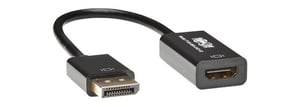 If you’re sending DisplayPort or Mini DisplayPort signals from a computer or other video source to a VGA, DVI or HDMI monitor, you’ll need an adapter/converter. The choice of an active or passive adapter depends on the type of signal from the video source, how many monitors you’re using, and whether your video source supports dual-mode DisplayPort (DP++) output.
If you’re sending DisplayPort or Mini DisplayPort signals from a computer or other video source to a VGA, DVI or HDMI monitor, you’ll need an adapter/converter. The choice of an active or passive adapter depends on the type of signal from the video source, how many monitors you’re using, and whether your video source supports dual-mode DisplayPort (DP++) output.
What is a Passive DisplayPort Adapter?
If your video source supports dual-mode DisplayPort (DP++), you can use a passive adapter to send DisplayPort video to a single-link DVI or HDMI monitor. The DP++ video source performs the conversion instead of the adapter. Source devices that support dual-mode DisplayPort are usually marked with the DP++ logo. If you’re connecting to multiple monitors, you might need an active adapter.
What is an Active DisplayPort Adapter?
An active DisplayPort adapter converts both single-mode and dual-mode output, so your connected video sources don’t have to support DP++. The adapter performs the conversion from DisplayPort to VGA, DVI or HDMI instead of the source device. Active adapters/converters are ideal for use with graphic cards such as AMD Eyefinity™ that do not output dual-mode signals.
How to Tell if a DisplayPort Adapter is Active or Passive
All DisplayPort to VGA adapters are active. DisplayPort to HDMI and DisplayPort to DVI adapters can be either active or passive. Active adapters have a chip (semiconductor) to boost the performance of that device. If there is no chip, the adapter is considered passive. Basically, if the adapter includes a little box that houses the conversation chip it is active. If the adapter cable is no bigger than a regular plug, it is most likely passive.
How to Connect to Multiple Monitors
If you’re planning to connect your DisplayPort video source to multiple VGA, DVI or HDMI monitors, you’ll probably need an active adapter, whether your video source supports DP++ or not. This is because some graphics cards cannot support DP++ output on multiple monitors. Most likely you’ll also need an active adapter if you’re using multiple source devices. Device capabilities vary, so check with the graphics card manufacturer for the type of adapter that is best for your application.
DisplayPort Multi-Stream Transport (MST) hubs are also an option for greater functionality when connecting a DisplayPort video source to multiple monitors. To take full advantage of MST features, like creating a video wall, your graphics card should support DisplayPort 1.2 standards.
Contact your local Accu-Tech representative to learn more about Tripp Lite's DisplayPort adapters.


.png?width=58&height=58&name=X_logo_2023_(white).png)
